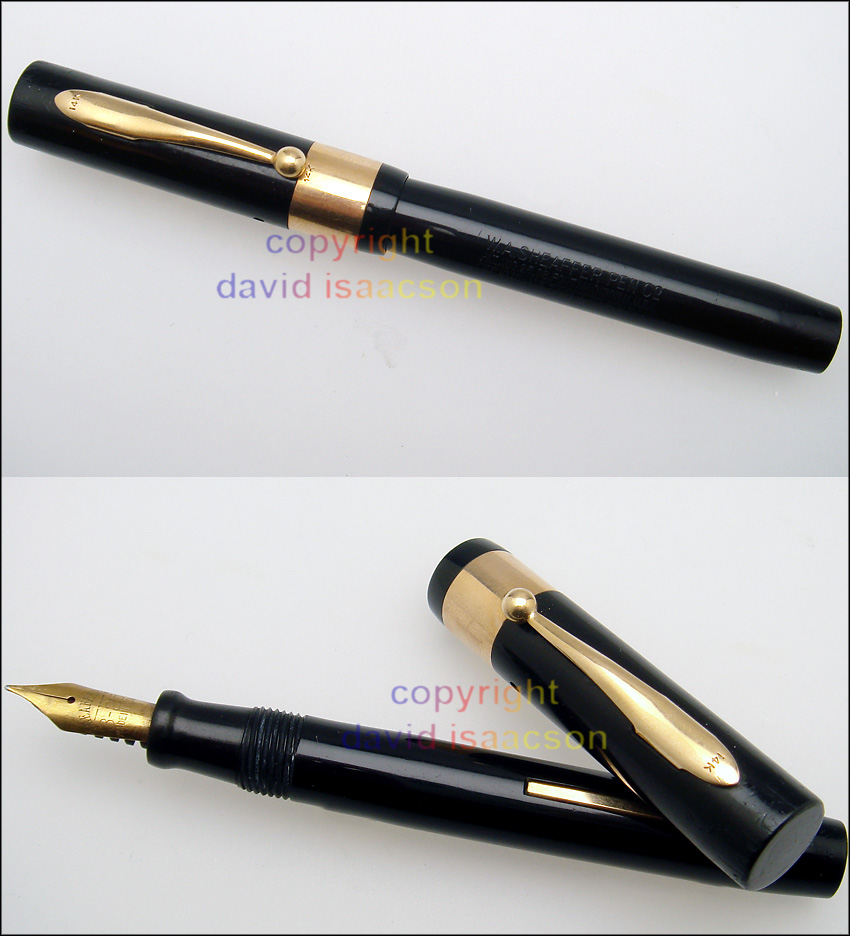I did not define my claim clearly enough. I am not saying flexible nibs were the original aim of the ebony line but, had become a major reason for it in the 1925 catalogue and I am quoting the 1925 catalogue when I say the pen was for those that demanded flexible nibs. Now it is very true that they never made a lifetime in the 1st width class of pens (those generally around .48" and width class is my own nomenclature for it - 22SS and 3-25 radite). But, they made one in the .52" (yes, I have an 84C with 14K trim - the band being 3/8" - model number me that!) so I think it clear that these could have been offered instead of a direct continuation of the Ebony line as both of my pens are in the first diameter class and match lenghs used by earlier Ebony line pens. I'm not sure why Sheaffer would continue to offer an Ebony line pen that is last described as a flexible nib arrangement unless that is the reason for continuing the line. As we have no documentation to refute this your strong disagrement with the statement is unwarranted (you may disagree all you want - I'm just saying there ain't a huge lot to support for either one of us after a point).
I have a hard time saying what the right nibs in these should be as I keep them as I find them as two of my Ebonys didn't have nibs and the last radite Ebony I show has a 2 Self Filling (nail) which is very out of date for a 1935 pen (so I strongly suspect it is not original). Why don't they oddly have the right nibs or nibs at all? As I posited some time before I think people had gotten used to stiff nibs and these flexible ones got broken. The 1935 one got a 2 Self Filling replacement because as you say there isn't a LT nib for this slight a diameter so they got the appropriate size though a 3 would have seemed a more likely candidate for 1935.
Roger W.
I'm not quite following all of your reasoning here; I can usually track your thoughts but the writing style in this case is just a bit too stream-of-consciousness for me to decode.
I disagree with the claim that the reason for the offering of the Ebony line in 1925 was as a flexible-nibbed alternative to Lifetime models; if that were the case, why wouldn't it be a full line rather than just a few slender pens with solid gold trim? You say,
"flexible nibs...had become a major reason for [the existence of the Ebony line] in the 1925 catalogue and I am quoting the 1925 catalogue when I say the pen was for those that demanded flexible nibs"
But this is not at all accurate. First, you are not quoting the catalog accurately, and I disagree with the inference you make from what the catalog actually does say. Here's the first paragraph of the description of the Ebony line:
"A perfectly made pen of ebon hued rubbber for those who desire a distinctive and conservative pen of unusually high grade."
The nib characteristics are clearly not the primary reason Sheaffer puts forth for the positioning of this line. The second paragraph goes on,
"The lack of any chasing or ornament of any kind except the solid 14K bands lends an air of refinement and distinction to the Ebony line...."
Again, the overall style of the pen is what is being promoted.
Not until the final paragraph, as with the descriptions of most of the lines in the catalog, is the nib offering mentioned:
"The points are size No. 2, ideally suited for those who demand flexibility and satin smoothness..."
But this is clearly just complimentary (praising) language for Sheaffer's nibs -- surely we can't conclude that, for example, if one wants "satin smoothness", only the pens in the Ebony line have that attribute.
And contrary to your assertion that "I am quoting the 1925 catalogue when I say the pen was for those that demanded flexible nibs", the catalog clearly states that
the No. 2 nib -- not the pens in the Ebony lline -- "is ideally suited for those who demand flexibility and satin smoothness."
Note further that the description continues,
"Points are furnished extra fine, fine, medium, coarse, posting, stub,
and manifold [emph added]."
Or, in other words, if you want a slender, un-ornamented black pen with 14K trim, the Ebony line is for you. And you can have whatever nib style you like.
Note that the Ebony line in the '25 catalog has no overlap whatsoever with the Lifetime line as far as model size, so the notion that it existed as a parallel alternative only for those who wanted a flex nib makes no sense from that standpoint -- there are no parallel models.
If every example seen so far of a non-Lifetime 14K-trimmed flat top is in a size not available in the Lifetime line, is that size distinction not the most likely reason to account for the continued production of a subset of the Ebony line into the late '20s-mid-'30s, given the data before us?
--Daniel





















